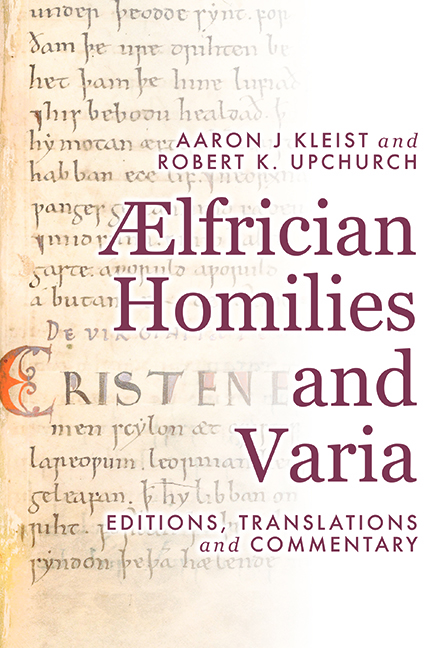Book contents
- Frontmatter
- Contents
- Preface
- Acknowledgements
- Abbreviations
- Sigla for Cited Ælfrician Manuscripts
- Dates for Cited Ælfrician Works
- Editorial Conventions
- Conventions Used in the Commentaries
- Homilies The Proper of the Season
- Homilies The Proper of the Saints
- Ælfrician Homilies and Varia: Editions, Translations, and Commentary: Volume II
- Homilies The Common of the Saints
- Homilies Unspecified Occasions
- Varia
- Works Cited
- Index
- ANGLO-SAXON TEXTS
7 - Assumption of Mary (15 August): De sancta uirginitate, uel de tribus ordinibus castitatis (‘Concerning Holy Virginity, or Concerning the Three Orders of Chastity’)
Published online by Cambridge University Press: 05 March 2024
- Frontmatter
- Contents
- Preface
- Acknowledgements
- Abbreviations
- Sigla for Cited Ælfrician Manuscripts
- Dates for Cited Ælfrician Works
- Editorial Conventions
- Conventions Used in the Commentaries
- Homilies The Proper of the Season
- Homilies The Proper of the Saints
- Ælfrician Homilies and Varia: Editions, Translations, and Commentary: Volume II
- Homilies The Common of the Saints
- Homilies Unspecified Occasions
- Varia
- Works Cited
- Index
- ANGLO-SAXON TEXTS
Summary
De sancta uirginitate, uel de tribus ordinibus castitatis (‘Concerning Holy Virginity, or Concerning the Three Orders of Chastity’) is a composite homily assigned to the Assumption of the Virgin Mary (15 August) in the one manuscript wherein it survives. Scholars agree that Ælfric composed its component parts but are less certain that he was responsible for the whole. With varying degrees of reservation, Godden, Pope, and Clemoes acknowledge the possibility that Ælfric could have compiled the homily, while more recently Kezel concludes that we are ‘reasonably justified’ in attributing the work to him. If Ælfric was the compiler, then he completed the homily between about 1006 and 1010 using parts of two works that he had written around 1005–6. De sancta uirginitate would have been his third homily for the feast-day commemorating the Virgin Mary's reception into heaven in body and soul at the end of her life.
Part one of De sancta uirginitate [lines 1–213] is adapted from Ælfric's Letter to Sigefyrth, a freely composed defense of sacerdotal chastity addressed to a layman who may have been a member of the local gentry living near Ælfric's abbey at Eynsham. Ælfric opens with proofs that Christ loves þa halgan clænnysse (‘holy virginity’ [line 3]). Jesus, the Virgin Mary, John the Evangelist, and the Apostles who forsook their marriages when called to follow Christ provide biblical support for Ælfric's assertion that lifelong celibacy and good works on earth merit a hundred-fold reward in heaven [lines 2–46]. A discussion of a particular kind of celibacy, clerical celibacy, follows [lines 47–120], and Ælfric grounds it in the distinction between the Old and New Law, the time of bigamy and married bishops having given way to the age of unmarried, chaste priests who alone can serve at God's altar. The need for an accurate understanding of differences between the Old and New Law extends to all Christians who need teachers to teach them about the three conditions that are pleasing to God – marriage, widowhood, and lifelong virginity – and whose good fruit yields, respectively, thirty, sixty, and hundred-fold heavenly rewards [lines 121–82]. Having explained the hundred-fold reward, Ælfric continues to comment on the virginal state.
- Type
- Chapter
- Information
- Ælfrician Homilies and VariaEditions, Translations, and Commentary, pp. 375 - 422Publisher: Boydell & BrewerPrint publication year: 2022

